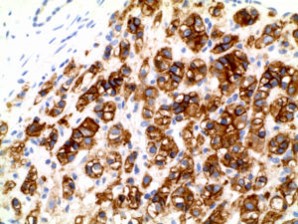
Carbonic anhydrase IX by IHC-12376 - Technical only, 12379 - Technical & interpretation
Test info
Carbonic anhydrase IX by IHC
12376 - Technical only, 12379 - Technical & interpretation
LAB12376
LAB12379
LAB12379
CAIX
- All IHC stains will include a positive control tissue
- CAIX is a highly sensitive marker for clear cell RCC
- CAIX is characteristically over-expressed in clear cell RCC a diffuse (75-100% of cases) or focal (25% of cases) membranous pattern. Decreased membranous staining can be seen in high grade tumors
- CAIX staining in clear cell papillary carcinoma is very distinctive, with positive staining seen in virtually all tumor cells limited to the cytoplasmic membrane along the basal and lateral aspects of the cell, sparing the luminal border ("cup-like" staining)
- Chromophobe RCC has only rarely been reported to express CAIX
- Epithelioid angiomyolipoma (E-AML) is CAIX negative
- MiTF-TFE translocation-associated carcinomas may express CAIX and epithelial markers, although most are negative for these markers or show focal immunoreactivity
- CAIX has been reported to be positive in the majority of sarcomatoid clear cell RCCs in a diffuse membranous pattern but not in other RCC variants
- Other genitourinary or adrenal tumours that can have a clear cell appearance including urothelial, squamous cell, clear cell adeno and adrenal cortical carcinoma and Sertoli cell tumors, and thus can express CAIX
- CAIX positivity within clear cell RCC has been correlated with response to treatment with interleukin (IL)-2, and has been utilized in targeted therapy
- In normal human tissues, CAIX expression is limited to very few organs including gastric mucosa, biliary tract, small intestine, and some fetal tissues
- CAIX has also been noted to strongly stain capillary hemangioblastoma8, which may resemble metastatic clear cell RCC. Both clear cell RCC and capillary hemangioblastoma (HAB) are associated with von Hippel-Lindau disease. In brain tumors where the differential diagnosis includes metastatic RCC and HAB, additional immunohistochemical workup may be necessary to make the distinction. CAM5.2, RCC antigen and CD10 frequently stain metastatic RCC, while alpha inhibin often stains HAB9
Specimen
Tissue
Submit a formalin-fixed, paraffin embedded tissue block
Formalin-fixed, paraffin embedded (FFPE) tissue block
FFPE tissue section mounted on a charged, unstained slide
Ambient (preferred)
- Unlabeled/mislabeled block
- Insufficient tissue
- Slides broken beyond repair
Performance
AHL - Immunohistochemistry
Mo - Fr
1 - 2 days
Immunohistochemical staining and microscopic examination
Clinical and Interpretive info
If requested, an interpretive report will be provided
Specifications
- Carbonic anhydrase IX (CAIX) in a transmembrane member of the carbonic anhydrase family of genes and has a role in CO2 transport, regulation of pH, and has been implicated in cell proliferation, adhesion, and invasion
- It is under the regulation of the hypoxia-inducible factor, which is invariably dysregulated in clear cell RCC
Staining patterns
- Membranous staining pattern (disregard cytoplasmic staining)
- Do not evaluate CAIX in areas adjacent to necrosis, since positive staining can be seen in any tumor because of hypoxia
References
- Reuter VE et al: Best Practices Recommendations in the Application of Immunohistochemistry in the Kidney Tumors; Report From the International Society of Urologic Pathology Consensus Conference, Am J Surg Pathol 2014;38:e35–e49).
- Donato DP et al: Expression of carbonic anhydrase IX in genitourinary and adrenal tumours. Histopathology 2011, 59, 1229–1239.
- Gupta R et al: Diagnostic Implications of Transcription Factor Pax 2 Protein and Transmembrane Enzyme Complex Carbonic Anhydrase IX Immunoreactivity in Adult Renal Epithelial Neoplasms. Am J Surg Pathol 2009;33:241–247.
- Stillebroer AB et al: Carbonic Anhydrase IX in Renal Cell Carcinoma: Implications for Prognosis, Diagnosis, and Therapy. European Urology 5 8 (2 01 0 ) 75 – 8 3.
- Al-Ahmadie HA et al: Carbonic Anhydrase IX Expression in Clear Cell Renal Cell Carcinoma; An Immunohistochemical Study Comparing 2 Antibodies. Am J Surg Pathol 2008;32:377–382.
- Genega EM et al: Carbonic Anhydrase IX Expression in Renal Neoplasms;Correlation With Tumor Type and Grade. Am J Clin Pathol 2010;134:873-879.
- Bing Z et al: Role of carbonic anhydrase IX, α-methylacyl coenzyme a racemase, cytokeratin 7, and galectin-3 in the evaluation of renal neoplasms: a tissue microarray immunohistochemical study. Annals of Diagnostic Pathology 17 (2013) 58–62.
- Proescholdt MA, Mayer C, Kubitza M, Schubert T, Liao SY, Stanbridge EJ, Ivanov S, Oldfield EH, Brawanski A, Merrill MJ. Expression of hypoxia-inducible carbonic anhydrases in brain tumors. Neuro Oncol. 2005 Oct;7(4):465-75. PubMed PMID: 16212811.
- Polydorides AD, Rosenblum MK, Edgar MA. Metastatic renal cell carcinoma to hemangioblastoma in von Hippel-Lindau disease. Arch Pathol Lab Med. 2007 Apr;131(4):641-5. PubMed PMID: 17425399.
Billing
88342 - 1st stain
88341 - each additional stain
88341 - each additional stain
Tracking
05/15/2017
10/17/2018
01/12/2024
